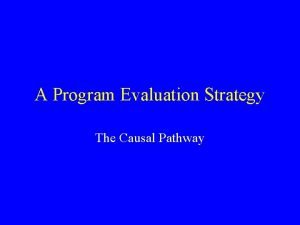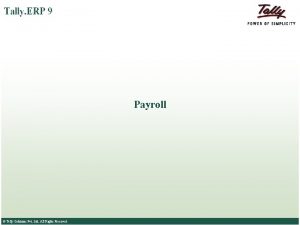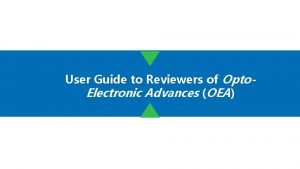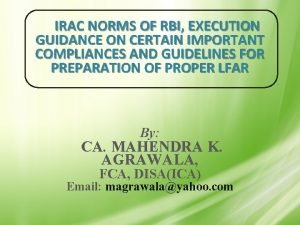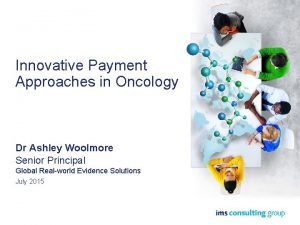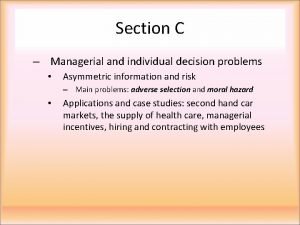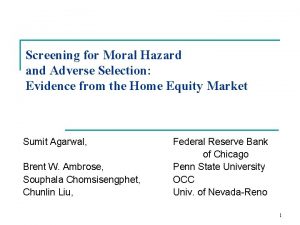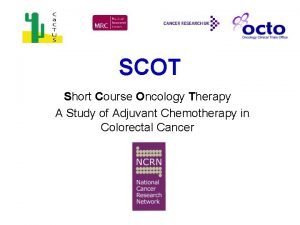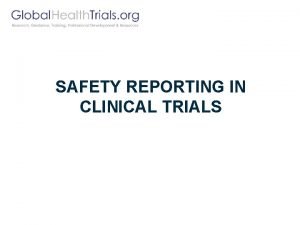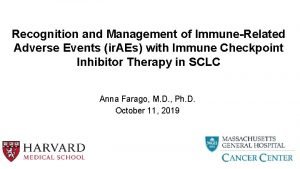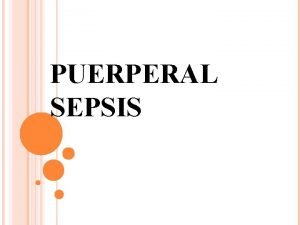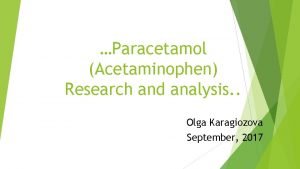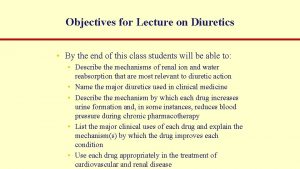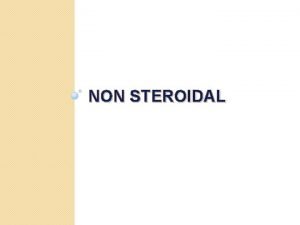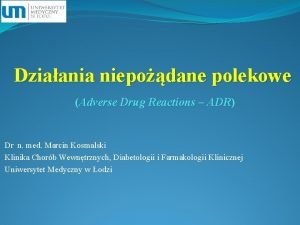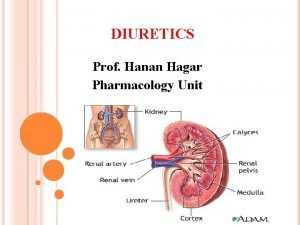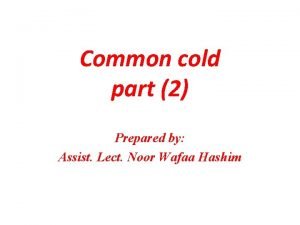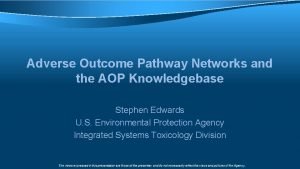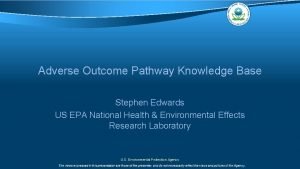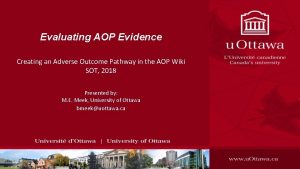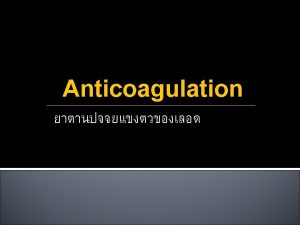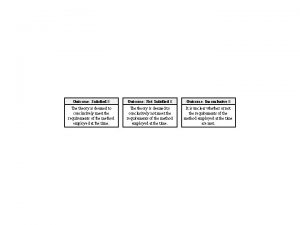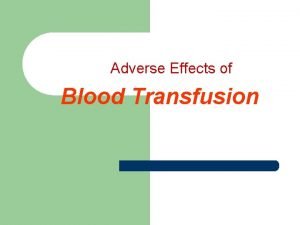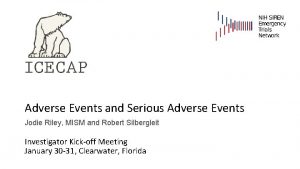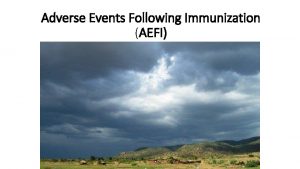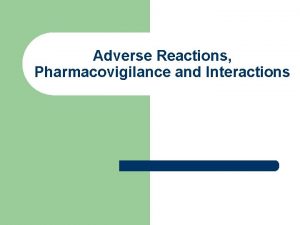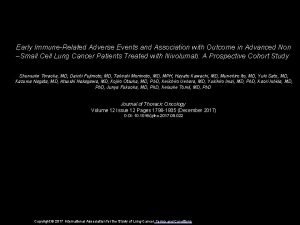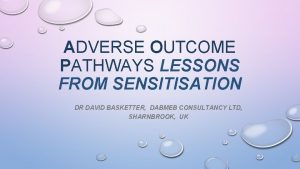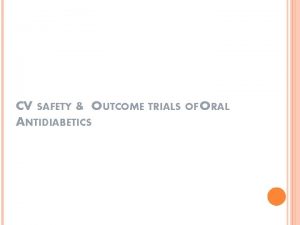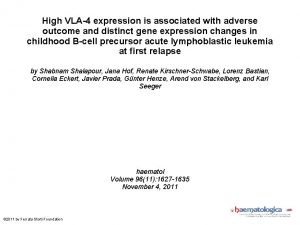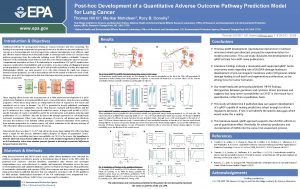Application of the Adverse Outcome Pathway Framework Advances































- Slides: 31

Application of the Adverse Outcome Pathway Framework: Advances and Challenges Daniel L. Villeneuve US EPA* Mid-Continent Ecology Division, Duluth, MN, USA *The contents of this presentation neither constitute nor necessarily reflect US EPA policy. Mention of trade names or commercial products does not indicate endorsement or recommendation for use. Creating a Safer and Healthier World by Advancing the Science and Increasing the Impact of Toxicology

21 st Century Toxicity Testing We can rapidly and cost effectively generate pathway-based data • Activity of 1000 s of chemicals in 100 s of pathways Wealth of basic biology and mechanistic toxicology studies in the extant literature Scientific challenge of the 21 st C…. How do we make effective use of those data and our wealth of existing scientific knowledge to support regulatory decision-making? AOPs are part of the solution.

An Adverse Outcome Pathway (AOP) is a conceptual framework that portrays existing knowledge concerning the linkage between a direct molecular initiating event and an adverse outcome, at a level of biological organization relevant to risk assessment. (Ankley et al. 2010, Environ. Toxicol. Chem. , 29(3): 730 -741. ) Toxicant Chemical Properties Macro. Molecular Interactions Receptor/Ligand Interaction Cellular Responses Gene activation DNA Binding Protein production Protein Oxidation Altered signaling Organ Responses Organism Responses Population Responses Altered physiology Lethality Structure Impaired Development Recruitment Disrupted homeostasis Altered tissue development/ function Impaired Reproduction • Helps us organize what we know • And utilize that knowledge to support risk-based decision-making Extinction

Outline • Advances in the AOP framework since January, 2014 • Core principles of AOP development • Public release of AOP-Knowledgebase • Challenges to application of AOP framework for risk assessment and regulation

Principles of AOP Development 1. AOPs are not chemical-specific • Not trying to describe what a single chemical does • Trying to describe what ANY chemical that perturbs the MIE with sufficient potency and duration is likely to do- Biological motifs of failure • Describing AOP does not require chemical-specific information. • Applying those motifs in a predictive context requires understanding chemical-specific properties (e. g. , potency, ADME) that dictate the magnitude and duration of perturbation at the MIE. Chlorpyrifos ACh. E Diazinon inhibition Fenthion Parathion Malthion Aldicarb Carbaryl Propoxur Methomyl ………. . Aceytocholine in synapses, accumulation Ataxia, paralysis, induced Respiratory distress, increased Mortality, increased Volz et al. 2011. Toxicol. Sci. 123: 349 -358 Russom et al. 2014. Environ. Toxicol. Chem. 33: 2157 -2169

Principles of AOP Development 2. AOPs are Modular Two Primary Building Blocks Key Events (KEs) • Functional unit of observation/verification • Observable ∆ biological state (measurable) • Essential (but not necessarily sufficient) • Description • Methods for observing/measuring • Taxonomic applicability

Principles of AOP Development 2. AOPs are Modular Two Primary Building Blocks Key Event Relationships (KERs) Key event up Key event down • Functional unit of inference/extrapolation • Define a directed relationship • State of KEup provides some ability to predict or infer state of KEdown • Supported by plausibility and evidence • Quantitative understanding

Principles of AOP Development 3. AOPs are a pragmatic unit of development and evaluation Aromatase Inhibition Granulosa Reduced E 2 synthesis Plasma Reduced circulating E 2 Hepatocyte Reduced VTG production Ovary Impaired Oocyte Dev. Female Decreased ovulation/spawn Population Declining Trajectory • By convention AOP consists of a single sequence of key events connecting an MIE to AO (no branches) • AOP is a pragmatic simplification of complex biology • For a “pure ligand” – functional unit of One set of directions from point A to point prediction B, not the map of all possible routes

Principles of AOP Development 4. For most real-world applications, AOP networks are the functional unit of prediction Chemicals with multiple biological activities Exposure to multiple chemicals Diuron Imidacloprid Linuron Terbuthylazine 2, 4 -D MCPP Propachlor ESA Butalbital Diclofenac Furosemide Gemfibrozil Ibuprofen Naproxen Phenobarbital Phenytoin Sulfamethoxazole Triclosan Acebutolol Albuterol Amitriptyline AOPs are not triggered in isolation. They interact.

Principles of AOP Development 4. For most real-world applications, AOP networks are the functional unit of prediction Key events shared by multiple AOPs KERs shared by multiple AOPs AR Agonism Aromatase Inhibition CYP 17, CYP 11 A Inhibition ER Antagonism Hypothalamic Neurons (-) Feedback Theca/ Granulosa Reduced T & E 2 synthesis Granulosa Reduced E 2 synthesis Theca/Granulosa Reduced T & E 2 Synthesis Plasma Reduced circulating E 2 Hepatocyte Reduced VTG production Ovary Impaired Oocyte Dev. Female Decreased ovulation/spawning Population Declining Trajectory

Principles of AOP Development 4. For most real-world applications, AOP networks are the functional unit of prediction AR Agonism Aromatase Inhibition CYP 17, CYP 11 A Inhibition ER Hypothalamic Neurons (-) Feedback Granulosa Reduced E 2 synthesis Plasma Reduced circulating E 2 Hepatocyte Reduced VTG production Ovary Impaired Oocyte Dev. Female Decreased ovulation/spawning Population Declining Trajectory • By building modular AOPs, we gradually describe the complexity of potential interactions. Antagonism • AOPs meet systems biology

Principles of AOP Development 5. AOPs are living documents • AOPs are a way of organizing existing knowledge • As methods for observing biology evolve: • New possibilities for KEs • Ability to measure KEs with greater precision/accuracy • As new experiments are published: • Weight of evidence supporting (or rejecting) KERs grows • New AOPs and new branches in AOP networks discovered • There is no objective “complete AOP”

Principles of AOP Development 5. AOPs are living documents Operationally-defined “stages” of AOP development Stages of AOP Development Characteristics Putative AOPs: Hypothesized set of KEs and KERs primarily supported by biological plausibility and/or statistical inference • Depth of evidence /understanding Formal AOPs: Include assembly and evaluation of the supporting weight of evidence – developed in AOP knowledgebase in accordance with internationally-harmonized OECD guidance • Transparency /defensibility Quantitative AOPs: Supported by quantitative relationships and/or computational models that allow quantitative translation of key event measurements into predicted probability or severity of adverse outcome Increasing • Quantitative precision • Cost • Data needs • Time • All stages have potential utility • Level of development desired/required depends on the application

Transferrable Knowledge Needs from a user standpoint: • Systematically organized • Transparent, well documented • Scientifically-defensible, credible • Accessible and searchable • Integration and analysis Needs from a developer standpoint: • Collaboration / crowd-sourcing • Avoiding duplicative effort Users’ handbook supplement to OECD guidance document for developing and assessing AOPs.

https: //aopkb. org/ AOP-Wiki publically accessible since September, 2014 Other modules and tools under development

Modular organization. Allows independent KE, KER pages to be linked to multiple AOPs. Page contents align with sections of the “User’s Handbook”

AOP-KB supports principles of AOP development AOPs are modular • KEs and KERs are shared by multiple AOPs • No need to re-write the same descriptions over and over • Reusability (best practices) AOPs are living documents • KE and KER descriptions can be expected to evolve over time • As descriptions are updated and expanded – all AOP descriptions they link to update automatically AOP networks for prediction • Entry of structured information in KB allows for de-facto assembly of AOP networks.

Challenges

Expanding the KB As of Oct. 20, 2015 113 AOPs 14 under review 17 open for comment

Expanding the KB 1% - Respiratory Other Kidney Immune Metabolic/ Energy [P ER 3% [PERCENTAGE] CE [PER CENTNT AGE]AG ME]u scle [PERCENTAGE] Heart/ Va scular [PERCENTAGE] Liver 4% [PERCENTAGE] Reproductive/endocrine [PERCENTAGE] Central Nervous System [PERCENTAGE] Carcinogenicity[PERCENTAGE] Developmental

Expanding the KB 23 26 Other MIE Tox. Cast MIE 15 23 Tox. Cast KE Other KE 3 Tox. Cast N/A KE

OECD AOP Development Project 1. 29 A catalog of putative AOPs that will enhance the utility of US EPA Tox. Cast high throughput screening data for hazard identification • Focused on breadth, not depth • Hypothesized set of KEs and KERs primarily supported by biological plausibility and/or statistical inference • A set of “skeleton” KE and KER pages on which the community could build • To the extent possible coordinating KE naming • Build some preliminary AOP networks with which to test AOP network visualization and analysis approaches.

Vocabulary: A current challenge in AOP creation • Very difficult to create a controlled vocabulary that can accommodate the diversity of potential KE, KERs that could be included in an AOP. • Lack of standardized naming and ontologies for genes, proteins, pathways, etc. particularly across fields and for different taxa. • Many terms that mean the same thing, or perhaps slightly different things to different people. • Even slight variants in title can lead to creation of separate pages for the same event • Steroid concentrations, reduced vs. steroid concentrations, decreased • reproduction, impaired vs. reproductive dysfunction, induced • Use existing KEs & KERs to create your AOP whenever possible

Incentivizing AOP development Award for Adverse Outcome Pathway Development for New Contributors to the AOP Wiki http: //www. piscltd. org. uk/aop-prize/

Fit for purpose for different applications is dictated by level of confidence in pathway-based inference. WOE evaluation essential to bridge the research/regulatory interface Prediction/extrapolation uncertainties Screening and prioritization Informed approaches to testing and assessment Quantitative risk assessment (low tier, low impact) Quantitative risk assessment (high tier, high impact)

To date, few studies are specifically designed for the purpose of AOP development Consideration Description Dose-response concordance Dose/concentrations needed to evoke change in Keup should be less than or equal to that needed to evoke Kedown. Temporal concordance Observation of KEup should precede observation of KEdown following administration of a stressor Incidence concordance KEup should be observed as frequently, if not more frequently, than KEdown. • Often comparing a “dog’s breakfast” of different studies. • Routes of exposure • Dose selection • Endpoints measured • Time at which measurements taken • Different replication/statistical power

Better understanding of the types of evidence that support AOPs can lead to design of experiments better suited for WOE evaluation Strongest independent evidence Weakest independent evidence 1. Plausibility 2. Essentiality 3. Empirical support (including quantitative understanding) • Dose-response concordance • Temporal concordance • Incidence concordance

Moving from development to predictive application Mode of Action Adverse Outcome Pathway Chemical ADME Target tissue Absorption, Distribution, Metabolism, Excretion Exposure As soon as apply an AOP to chemicalspecific prediction, need to consider ADME, chemical properties.

Moving from development to predictive application HPG axis model Aromatase Inhibition Granulosa Reduced E 2 synthesis Plasma Reduced circulating E 2 Hepatocyte Reduced VTG production Plasma Reduced circulating VTG Ovary Impaired Oocyte Dev. Female Decreased ovulation/spa wning Oocyte growth dynamics model Population Declining Trajectory

• Development and dissemination of core principles of AOP development and global access to the AOP-KB are major advances over the last two years. • Outreach and education regarding the framework is addressing critical challenges • Promoting connectivity within the KB • Promoting engagement by broader community • Design of studies tailored for AOP development • Ongoing research and development • Aligning predictive models with AOPs • Tools and approaches for AOP network analysis.

Adverse Outcome Pathway Discovery and Development Project Lead Contact: Villeneuve. dan@epa. gov Edwards. stephen@epa. gov National Program Director: Tina Bahadori Deputy NPD: Elaine Cohen Hubal NHEERL MI: Joseph Tietge NERL MI: John Kenneke NCCT MI: John Cowden Adams, Linda Ankley, Gerald Bencic, David Biales, Adam Borsay, Doranne Buckalew, Angela Bruon, Maribel Cardon, Mary Carswell, Gleta Chorley, Brian Collette, Tim Conolly, Rory Corton, Chris Degitz, Sigmund Dreher, Kevin Edwards, Stephen Ekman, Drew El-Masri, Hisham Evans, Nicola Flick, Robert Furr, Johnathan Gilbert, Mary E. Gordon, Denise Gray, Leon Hallinger, Daniel Hartig, Phil Haselman, Jon Hazari, Medhi Herr, David Hester, Susan Hotchkiss, Michelle Hornung, Michael Hughes, Michael Hunter, Sid Jayaraman, Saro Jensen, Karl Jensen, Kathleen Judson, Richard Kahl, Michael Kenyon, Elaina Klinefelter, Gary Kodavanti, Prasada Rao Korte, Joe Kosian, Pat Kostich, Mitch Lake, April Lambright, Christy Lasat, Mitch Laws, Susan Lyke, Danielle Mc. Queen, Charlene Miller, David H. Mills, Lesley Mills, Marc Moore, Tanya Mortensen, Holly Moser, Ginger Murr, Ashley Nelson, Gail Pleil, Joachim Rosen, Mitch Ross, Jeff See, MJ Sey, Yusupha Simmons, Jane Ellen Skelton, David Stoker, Tammy Strader, Lilly Suarez, Juan Tan, Cecilia Teng, Quincy Tennant, Alan Van. Duyn, Natalia Van. Emon, Jeanette Villeneuve, Dan Wang, Rong-Lin Ward, William Welch, Jeff Wilson, Vickie Wood, Charles
 Causal pathway framework
Causal pathway framework Axis powers
Axis powers Payroll in tally
Payroll in tally Advances in technology during wwii
Advances in technology during wwii Intellectual development of infants chapter 9
Intellectual development of infants chapter 9 Advances in real time rendering
Advances in real time rendering Photodesintegration
Photodesintegration Short term loans and advances
Short term loans and advances Opto-electronic advances
Opto-electronic advances Recent advances in dental ceramics
Recent advances in dental ceramics Dcco
Dcco Lurbinectedin posologie
Lurbinectedin posologie Advances in memory technology
Advances in memory technology Adverse reaction definition
Adverse reaction definition What is a sentinel event
What is a sentinel event Adverse selection
Adverse selection Adverse selection
Adverse selection Adverse reaction definition
Adverse reaction definition Adverse reaction definition
Adverse reaction definition Adverse events in hospital
Adverse events in hospital Adverse events in hospital
Adverse events in hospital Puerperal sepsis meaning
Puerperal sepsis meaning What is adverse selection
What is adverse selection Effects of paracetamol
Effects of paracetamol Loop diuretics adverse effects
Loop diuretics adverse effects Paracetamol dose per kg
Paracetamol dose per kg Dpp4 inhibitor adverse effects
Dpp4 inhibitor adverse effects Adverse selection
Adverse selection Adr adverse drug reaction
Adr adverse drug reaction Furosemide side effects
Furosemide side effects Diuretic drugs classification
Diuretic drugs classification Hayanil drug
Hayanil drug
